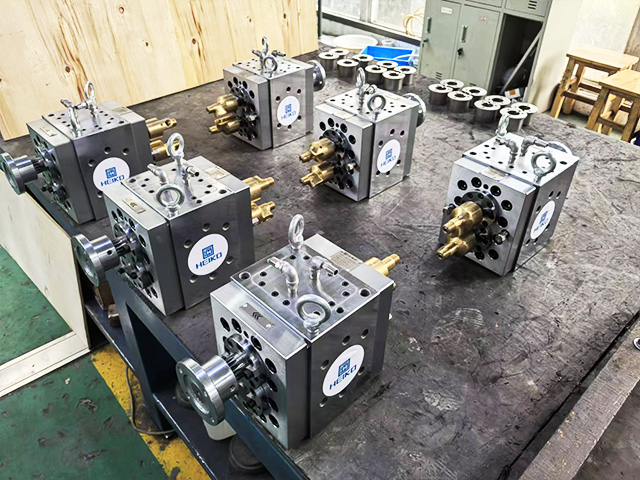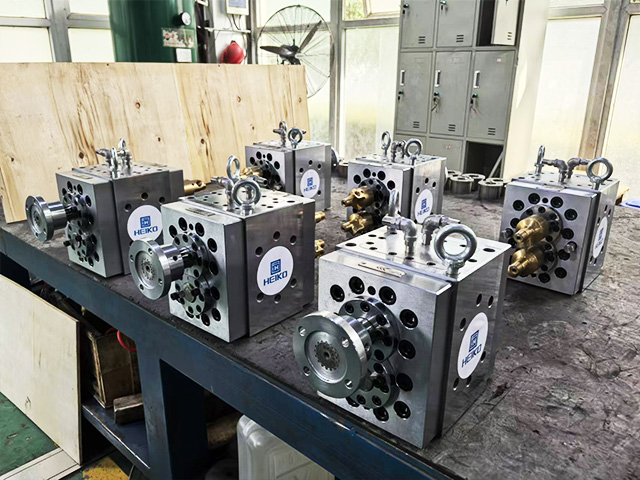25MM HDPE PP plastic rod extrusion production line melt pump
I. Application of Melt Pump in 25MM HDPE and PP Plastic Rod Extrusion Lines
In the 25MM HDPE and PP plastic rod extrusion lines, the primary function of the melt pump is to pressurize and stabilize the high-temperature plastic melt from the extruder, and then deliver it to the extruder head with a stable flow rate. Its ability to stabilize melt pressure and flow rate surpasses that of various types of extruders, thereby significantly enhancing the overall efficiency of the entire production line.
Specifically, the roles of the melt pump in the extrusion line include:
Pressurization and Stabilization: By pressurizing and stabilizing the high-temperature plastic melt, it ensures stable pressure during the extrusion process, thereby improving the quality of the extruded products.
Flow Rate Stabilization: By precisely controlling the flow rate of the melt, it ensures minimal dimensional tolerances in the extruded products, increasing the yield of finished products.
Increased Production Efficiency: When used in series with single-screw or co-rotating twin-screw extruders, the melt pump can significantly increase the production efficiency of the entire line.
II. Selection and Considerations for Melt Pumps
When selecting a melt pump, the following factors need to be considered:
Operating Temperature and Pressure: Choose an appropriate melt pump based on the operating temperature and pressure requirements of the extrusion line. Generally, the operating temperature of a melt pump can reach 300 degrees Celsius, and some melt pumps made of high-temperature-resistant materials can even reach 500 degrees Celsius. In terms of operating pressure, the inlet pressure of ordinary melt pumps is less than 10 MPa, the outlet pressure is less than 35 MPa, with a pressure difference of up to 25 MPa. For melt pumps with high pressure resistance, their outlet pressure can reach 50 MPa.
Material and Sealing: Due to the continuous operation of melt pumps under high temperature and pressure conditions, and the high viscosity and certain corrosion properties of the plastic melt being transported, the material requirements for melt pumps are very high. Melt pumps are usually made of alloy tool steel, with the gears and shafts integrated to ensure reliability under high torque conditions. Additionally, the lubrication and sealing issues of melt pumps are relatively complex, requiring the use of special lubricants or greases, and ensuring that the sealing structure adapts to the special properties of the plastic melt.
Flow Rate and Rotational Speed: The flow rate of melt pumps is strictly proportional to their rotational speed. Therefore, when selecting a melt pump, it is necessary to determine the appropriate rotational speed and flow rate based on the actual needs of the production line.
Furthermore, when using melt pumps, the following points need attention:
Regular Inspection and Maintenance: Regularly inspect and maintain the melt pump to ensure it is in good working condition.
Reasonable Adjustment of Operating Pressure and Temperature: Based on the actual needs of the production line, reasonably adjust the operating pressure and temperature of the melt pump to avoid damage caused by excessively high or low pressure and temperature.
Safety Operations: When operating the melt pump, follow relevant safety operating procedures to ensure the safety of personnel and equipment.
In summary, melt gear pumps play a crucial role in 25MM HDPE and PP plastic rod extrusion lines. By selecting and using melt pumps reasonably, the production efficiency and product quality of the production line can be significantly improved.
Email: sale@heikomachinery.com
WhatsApp: +86 13803717447
Previous:What is the scope of application of plastic film screen changer?
Next:What are the disadvantages of melt transfer pumps

